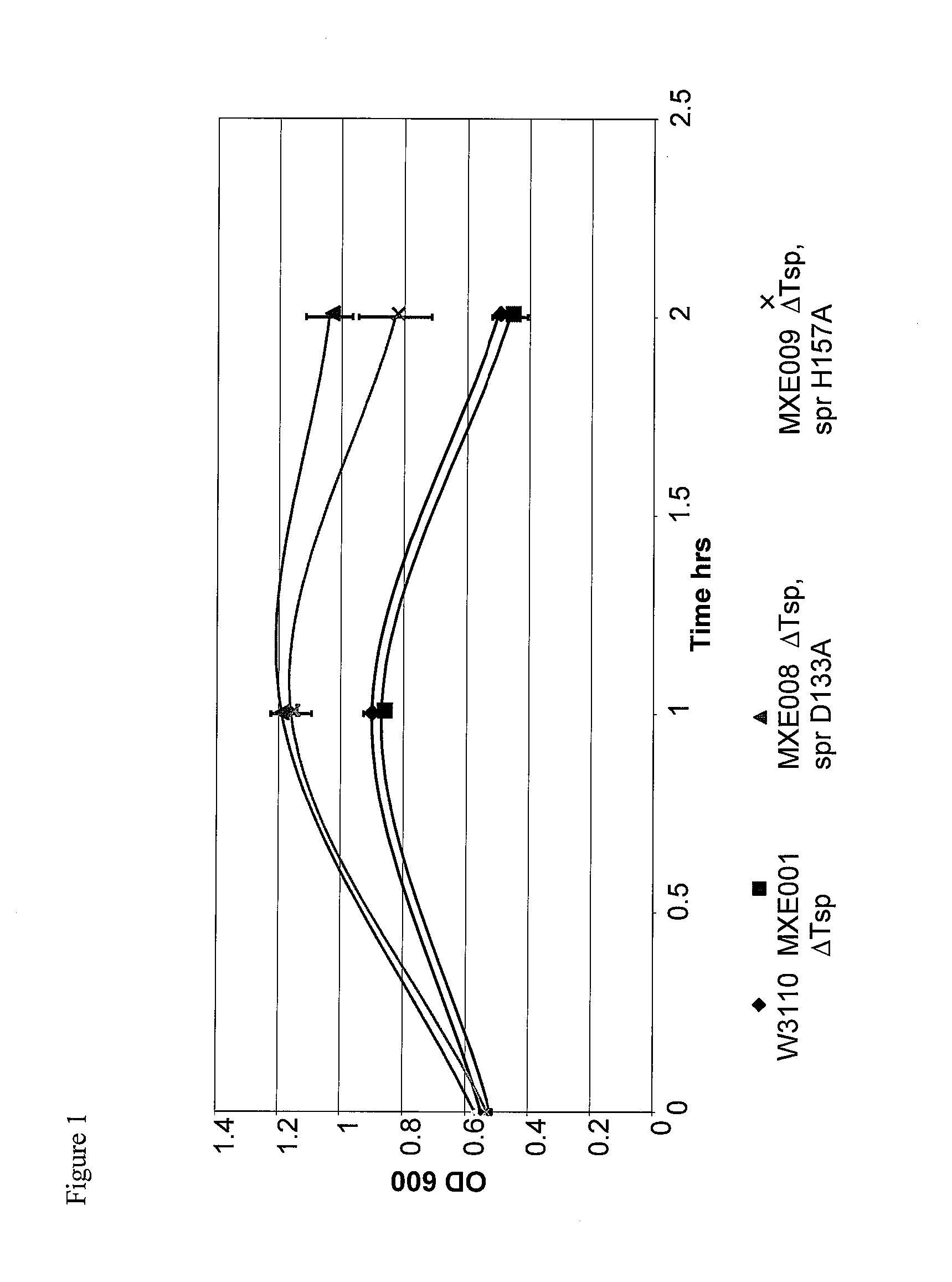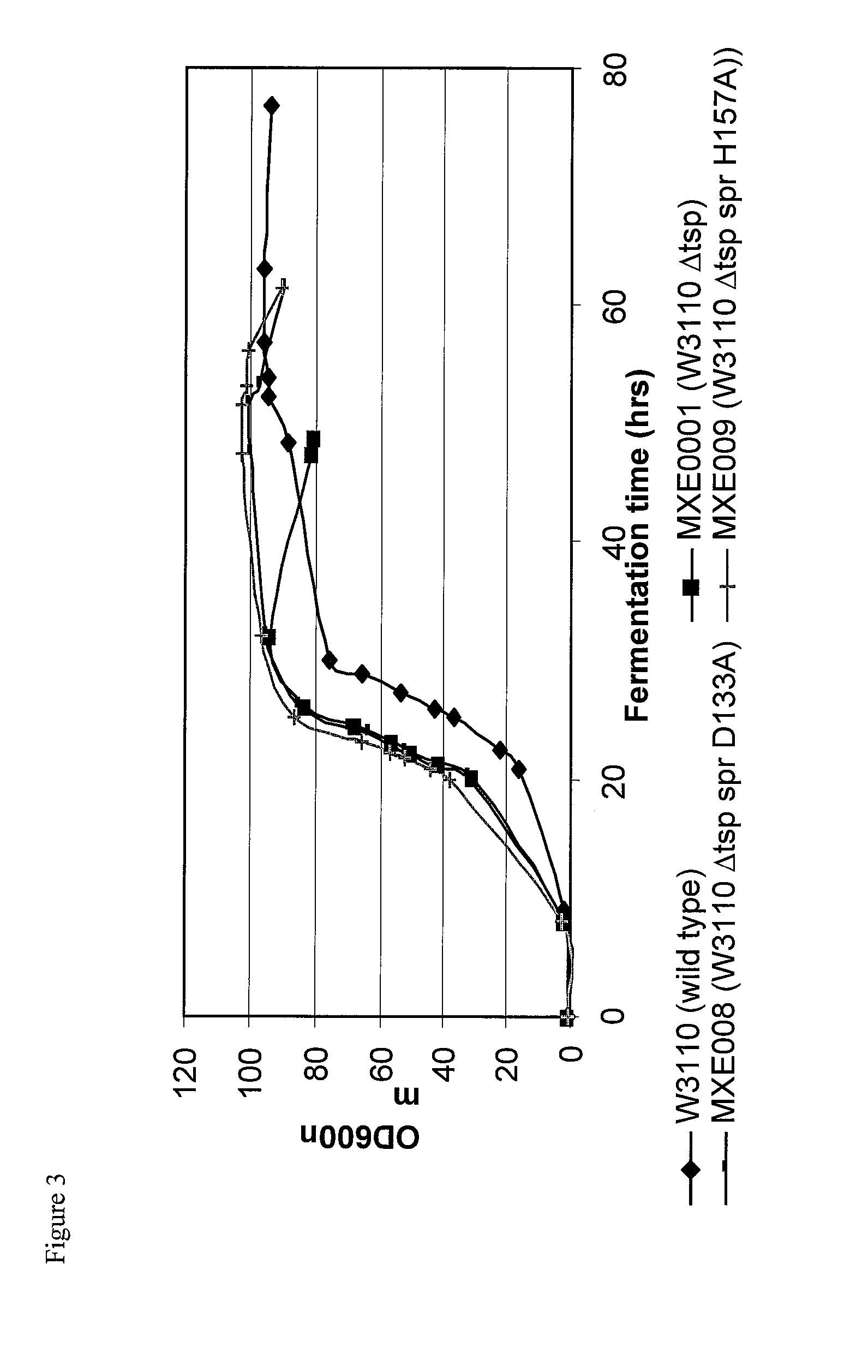Bacterial host strain comprising a mutant spr gene and having reduced tsp activity
- Summary
- Abstract
- Description
- Claims
- Application Information
AI Technical Summary
Benefits of technology
Problems solved by technology
Method used
Image
Examples
example 1
Generation Cell Strain MXE001 (ΔTsp)
[0326]The MXE001 strain was generated as follows:
[0327]The Tsp cassette was moved as Sal I, Not I restriction fragments into similarly restricted pKO3 plasmids. The pKO3 plasmid uses the temperature sensitive mutant of the pSC101 origin of replication (RepA) along with a chloramphenicol marker to force and select for chromosomal integration events. The sacB gene which encodes for levansucrase is lethal to E. coli grown on sucrose and hence (along with the chloramphenicol marker and pSC101 origin) is used to force and select for de-integration and plasmid curing events. This methodology had been described previously (Hamilton et al., 1989, Journal of Bacteriology, 171, 4617-4622 and Blomfield et al., 1991, Molecular Microbiology, 5, 1447-1457). The pKO3 system removes all selective markers from the host genome except for the inserted gene.
[0328]The following plasmids were constructed.
[0329]pMXE191 comprising the knockout mutated Tsp gene as shown i...
example 2
Generation of spr Mutants
[0346]The spr mutations were generated and selected for using a complementation assay.
[0347]The spr gene was mutated using the Clontech® random mutagenisis diversity PCR kit which introduced 1 to 2 mutations per 1000 bp. The mutated spr PCR DNA was cloned into an inducible expression vector [pTTO CDP870] which expresses CDP870 Fab′ along with the spr mutant. This ligation was then electro-transformed into an E. coli strain MXE001 (ΔTsp) prepared using the method found in Miller, E. M. and Nickoloff, J. A., “Escherichia coli electrotransformation,” in Methods in Molecular Biology, vol. 47, Nickoloff, J. A. (ed.), Humana Press, Totowa, N.J., 105 (1995). The following protocol was used, 40 ul of electro competent MXE001, 2.5 ul of the ligation (100 pg of DNA) was added to a 0.2 cm electroporation cuvette, electro-transformation was performed using as BioRad Genepulser Xcell with the following conditions, 2500V, 25 μF and 200Ω. After the electro-transformation 1...
example 3
Generation of Mutant E. coli Cell Strains Carrying spr Mutations
[0361]The individual mutations 1 to 5 identified in Example 2 and three catalytic triad mutations of spr (C94A, H145A, H157A) and W174R were used to generate new strains using either the wild-type W3110 E. coli strain (genotype: F-LAM-IN (rrnD-rrnE)1 rph1 (ATCC no. 27325)) to create spr mutated strains or MXE001 strain from Example 1 to make combined ΔTsp / mutant spr strains.
[0362]The following mutant E. coli cell strains were generated using a gene replacement vector system using the pKO3 homologous recombination / replacement plasmid (Link et al., 1997, Journal of Bacteriology, 179, 6228-6237), as described in Example 1 for the generation of MXE001.
TABLE 1Mutant E. coliCell StrainGenotypeSpr VectorsMXE001ΔTsp—MXE008ΔTsp, spr D133ApMXE339, pK03 spr D133A (-SalI)MXE009ΔTsp, spr H157ApMXE345, pK03 spr H157A (-SalI)MXE010spr G147CpMXE338, pK03 spr G147C (-SalI)MXE011spr C94ApMXE343, pK03 spr C94A (-SalI)MXE012spr H145ApMXE34...
PUM
 Login to View More
Login to View More Abstract
Description
Claims
Application Information
 Login to View More
Login to View More - R&D
- Intellectual Property
- Life Sciences
- Materials
- Tech Scout
- Unparalleled Data Quality
- Higher Quality Content
- 60% Fewer Hallucinations
Browse by: Latest US Patents, China's latest patents, Technical Efficacy Thesaurus, Application Domain, Technology Topic, Popular Technical Reports.
© 2025 PatSnap. All rights reserved.Legal|Privacy policy|Modern Slavery Act Transparency Statement|Sitemap|About US| Contact US: help@patsnap.com



